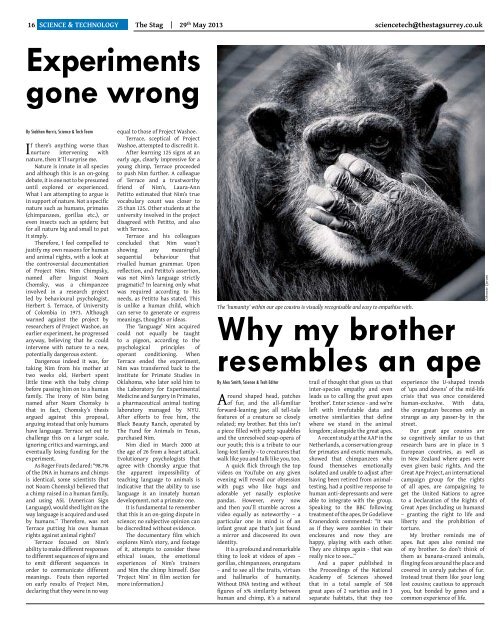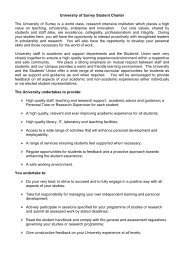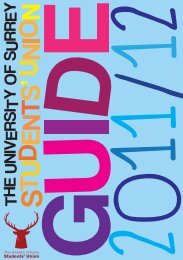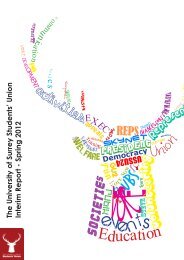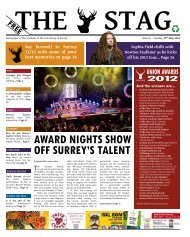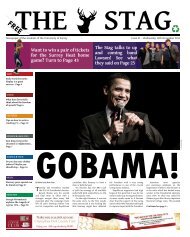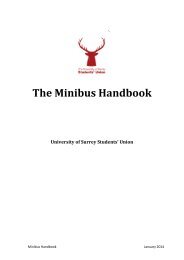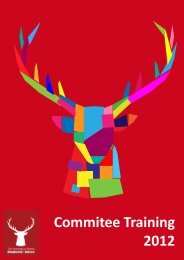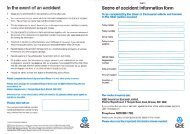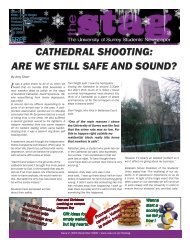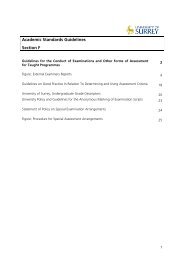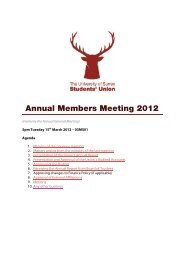Issue 60 - University of Surrey's Student Union
Issue 60 - University of Surrey's Student Union
Issue 60 - University of Surrey's Student Union
Create successful ePaper yourself
Turn your PDF publications into a flip-book with our unique Google optimized e-Paper software.
16 SCIENCE & TECHNOLOGY The Stag | 29 th May 2013 sciencetech@thestagsurrey.co.uk Sci/Tech Editor: Alex Smith | Copy Editor: Sophie Vickery<br />
The Stag | 29 th May 2013 SCIENCE & TECHNOLOGY 17<br />
Experiments<br />
gone wrong<br />
By Siobhan Harris, Science & Tech Team<br />
If there’s anything worse than<br />
nurture intervening with<br />
nature, then it’ll surprise me.<br />
Nature is innate in all species<br />
and although this is an on-going<br />
debate, it is one not to be presumed<br />
until explored or experienced.<br />
What I am attempting to argue is<br />
in support <strong>of</strong> nature. Not a specific<br />
nature such as humans, primates<br />
(chimpanzees, gorillas etc.), or<br />
even insects such as spiders; but<br />
for all nature big and small to put<br />
it simply.<br />
Therefore, I feel compelled to<br />
justify my own reasons for human<br />
and animal rights, with a look at<br />
the controversial documentation<br />
<strong>of</strong> Project Nim. Nim Chimpsky,<br />
named after linguist Noam<br />
Chomsky, was a chimpanzee<br />
involved in a research project<br />
led by behavioural psychologist,<br />
Herbert S. Terrace, <strong>of</strong> <strong>University</strong><br />
<strong>of</strong> Colombia in 1973. Although<br />
warned against the project by<br />
researchers <strong>of</strong> Project Washoe, an<br />
earlier experiment, he progressed<br />
anyway, believing that he could<br />
intervene with nature to a new,<br />
potentially dangerous extent.<br />
Dangerous indeed it was, for<br />
taking Nim from his mother at<br />
two weeks old, Herbert spent<br />
little time with the baby chimp<br />
before passing him on to a human<br />
family. The irony <strong>of</strong> Nim being<br />
named after Noam Chomsky is<br />
that in fact, Chomsky’s thesis<br />
argued against this proposal,<br />
arguing instead that only humans<br />
have language. Terrace set out to<br />
challenge this on a larger scale,<br />
ignoring critics and warnings, and<br />
eventually losing funding for the<br />
experiment.<br />
As Roger Fouts declared: “98.7%<br />
<strong>of</strong> the DNA in humans and chimps<br />
is identical, some scientists (but<br />
not Noam Chomsky) believed that<br />
a chimp raised in a human family,<br />
and using ASL (American Sign<br />
Language), would shed light on the<br />
way language is acquired and used<br />
by humans.” Therefore, was not<br />
Terrace putting his own human<br />
rights against animal rights?<br />
Terrace focused on Nim’s<br />
ability to make different responses<br />
to different sequences <strong>of</strong> signs and<br />
to emit different sequences in<br />
order to communicate different<br />
meanings. Fouts then reported<br />
on early results <strong>of</strong> Project Nim,<br />
declaring that they were in no way<br />
equal to those <strong>of</strong> Project Washoe.<br />
Terrace, sceptical <strong>of</strong> Project<br />
Washoe, attempted to discredit it.<br />
After learning 125 signs at an<br />
early age, clearly impressive for a<br />
young chimp, Terrace proceeded<br />
to push Nim further. A colleague<br />
<strong>of</strong> Terrace and a trustworthy<br />
friend <strong>of</strong> Nim’s, Laura-Ann<br />
Petitto estimated that Nim’s true<br />
vocabulary count was closer to<br />
25 than 125. Other students at the<br />
university involved in the project<br />
disagreed with Petitto, and also<br />
with Terrace.<br />
Terrace and his colleagues<br />
concluded that Nim wasn’t<br />
showing any meaningful<br />
sequential behaviour that<br />
rivalled human grammar. Upon<br />
reflection, and Petitto’s assertion,<br />
was not Nim’s language strictly<br />
pragmatic? In learning only what<br />
was required according to his<br />
needs, as Petitto has stated. This<br />
is unlike a human child, which<br />
can serve to generate or express<br />
meanings, thoughts or ideas.<br />
The ‘language’ Nim acquired<br />
could not equally be taught<br />
to a pigeon, according to the<br />
psychological principles <strong>of</strong><br />
operant conditioning. When<br />
Terrace ended the experiment,<br />
Nim was transferred back to the<br />
Institute for Primate Studies in<br />
Oklahoma, who later sold him to<br />
the Laboratory for Experimental<br />
Medicine and Surgery in Primates,<br />
a pharmaceutical animal testing<br />
laboratory managed by NYU.<br />
After efforts to free him, the<br />
Black Beauty Ranch, operated by<br />
The Fund for Animals in Texas,<br />
purchased Nim.<br />
Nim died in March 2000 at<br />
the age <strong>of</strong> 26 from a heart attack.<br />
Evolutionary psychologists that<br />
agree with Chomsky argue that<br />
the apparent impossibility <strong>of</strong><br />
teaching language to animals is<br />
indicative that the ability to use<br />
language is an innately human<br />
development, not a primate one.<br />
It is fundamental to remember<br />
that this is an on-going dispute in<br />
science; no subjective opinion can<br />
be discredited without evidence.<br />
The documentary film which<br />
explores Nim’s story, and footage<br />
<strong>of</strong> it, attempts to consider these<br />
ethical issues, the emotional<br />
experiences <strong>of</strong> Nim’s trainers<br />
and Nim the chimp himself. (See<br />
‘Project Nim’ in film section for<br />
more information.)<br />
The ‘humanity’ within our ape cousins is visually recognisable and easy to empathise with.<br />
Why my brother<br />
resembles an ape<br />
By Alex Smith, Science & Tech Editor<br />
trail <strong>of</strong> thought that gives us that experience the U-shaped trends<br />
inter-species empathy and even <strong>of</strong> ‘ups and downs’ <strong>of</strong> the mid-life<br />
round shaped head, patches leads us to calling the great apes crisis that was once considered<br />
A <strong>of</strong> fur, and the all-familiar ‘brother’. Enter science - and we’re human-exclusive. With data,<br />
forward-leaning jaw; all tell-tale<br />
features <strong>of</strong> a creature so closely<br />
related; my brother. But this isn’t<br />
a piece filled with petty squabbles<br />
and the unresolved soap-opera <strong>of</strong><br />
our youth; this is a tribute to our<br />
long-lost family – to creatures that<br />
walk like you and talk like you, too.<br />
left with irrefutable data and<br />
emotive similarities that define<br />
where we stand in the animal<br />
kingdom; alongside the great apes.<br />
A recent study at the AAP in the<br />
Netherlands, a conservation group<br />
for primates and exotic mammals,<br />
showed that chimpanzees who<br />
the orangutan becomes only as<br />
strange as any passer-by in the<br />
street.<br />
Our great ape cousins are<br />
so cognitively similar to us that<br />
research bans are in place in 5<br />
European countries, as well as<br />
in New Zealand where apes were<br />
A quick flick through the top found themselves emotionally even given basic rights. And the<br />
videos on YouTube on any given<br />
evening will reveal our obsession<br />
with pugs who like hugs and<br />
adorable yet nasally explosive<br />
isolated and unable to adjust after<br />
having been retired from animaltesting,<br />
had a positive response to<br />
human anti-depressants and were<br />
Great Ape Project, an international<br />
campaign group for the rights<br />
<strong>of</strong> all apes, are campaigning to<br />
get the United Nations to agree<br />
pandas. However, every now able to integrate with the group. to a Declaration <strong>of</strong> the Rights <strong>of</strong><br />
and then you’ll stumble across a<br />
video equally as noteworthy – a<br />
particular one in mind is <strong>of</strong> an<br />
infant great ape that’s just found<br />
a mirror and discovered its own<br />
identity.<br />
It is a pr<strong>of</strong>ound and remarkable<br />
thing to look at videos <strong>of</strong> apes –<br />
gorillas, chimpanzees, orangutans<br />
– and to see all the traits, virtues<br />
Speaking to the BBC following<br />
treatment <strong>of</strong> the apes, Dr Godelieve<br />
Kranendonk commented: “It was<br />
as if they were zombies in their<br />
enclosures and now they are<br />
happy, playing with each other.<br />
They are chimps again - that was<br />
really nice to see…”<br />
And a paper published in<br />
the Proceedings <strong>of</strong> the National<br />
Great Apes (including us humans)<br />
– granting the right to life and<br />
liberty and the prohibition <strong>of</strong><br />
torture.<br />
My brother reminds me <strong>of</strong><br />
apes. But apes also remind me<br />
<strong>of</strong> my brother. So don’t think <strong>of</strong><br />
them as banana-crazed animals,<br />
flinging feces around the place and<br />
covered in unruly patches <strong>of</strong> fur.<br />
and hallmarks <strong>of</strong> humanity. Academy <strong>of</strong> Sciences showed Instead treat them like your long<br />
Without DNA testing and without<br />
figures <strong>of</strong> x% similarity between<br />
human and chimp, it’s a natural<br />
that in a total sample <strong>of</strong> 508<br />
great apes <strong>of</strong> 2 varieties and in 3<br />
separate habitats, that they too<br />
lost cousins; cautious to approach<br />
you, but bonded by genes and a<br />
common experience <strong>of</strong> life.<br />
©Meneer Zjeroen<br />
App Corner<br />
Flipboard<br />
(iOS / Android)<br />
By Ankur Banerjee, Science & Tech Team<br />
Hardly any<br />
university students<br />
buy newspapers or<br />
magazines these days;<br />
it’s an industry-wide<br />
trend that has led to<br />
drops in subscriber<br />
numbers. The way that<br />
most <strong>of</strong> my friends get<br />
news is when someone<br />
shares a link on<br />
a social networking<br />
website, or by browsing<br />
through websites<br />
themselves. Yet, as a<br />
medium for scanning<br />
through content,<br />
websites tend to be poor because it’s hard to scan<br />
through large quantities <strong>of</strong> information.<br />
Flipboard is an app available on iOS and Android<br />
(for free) that <strong>of</strong>fers a solution to this problem.<br />
The app allows you to create a personalised<br />
magazine to include your favourite news and media<br />
sources online, whether it be broadsheets, blogs,<br />
fashion magazines, or YouTube channels. The user<br />
experience is gorgeous, as you can flick through<br />
items with rich, vivid images just like you would in<br />
a magazine – and then easily save or share stories<br />
online that you like on Facebook / Twitter. Lost<br />
for ideas on what sources to add? Flipboard has<br />
editorially-curated lists <strong>of</strong> best sources <strong>of</strong> news in a<br />
range <strong>of</strong> categories to quickly take your pick from –<br />
or you can add your own source. This app is perfect<br />
for any news junkie.<br />
Goodbye from the Science & Tech editor<br />
I’d be lying if I said that being the Science<br />
& Tech editor this year hasn’t<br />
been an utter pleasure. Not only have<br />
the team been outstanding, and Sophie<br />
Vickery as a fabulous copy editor, but<br />
we’ve covered such a great range <strong>of</strong> stories;<br />
from the death <strong>of</strong> Neil Armstrong to<br />
Felix Baumgartner’s jump from the edge<br />
<strong>of</strong> space. Science has come a long way<br />
in a year – to the point where we are<br />
©Flipchart<br />
At a home<br />
at the end <strong>of</strong><br />
Google Earth,<br />
orphan finds<br />
his lost mother<br />
By Fahmid Chowdhury, Science & Tech Team<br />
To us, Google Earth/Maps is<br />
an application which helps us<br />
find our way around a new town,<br />
search bus timetables or just take<br />
a look at an old neighbourhood<br />
we grew up in. However, to a man<br />
named Saroo, it was the key to<br />
finding his beloved mother.<br />
It all began at the age <strong>of</strong> 5<br />
when Saroo fell asleep whilst<br />
working on the train as a cleaner<br />
with his brother. He laid down to<br />
take a nap but woke up 14 hours<br />
later to realise that not only was<br />
his brother gone, but Saroo had<br />
also gone to Calcutta – very far<br />
away from his home.<br />
As he was now lost, he<br />
wandered around the streets<br />
<strong>of</strong> Calcutta, begging for basic<br />
necessities. All the while he had<br />
people approaching him looking<br />
suspicious, <strong>of</strong>fering him things<br />
that seemed too good to be<br />
true with malicious intentions.<br />
After some time, though, he was<br />
adopted by an orphanage and<br />
one day a couple from Australia<br />
decided to adopt him.<br />
Under their care, he grew<br />
up as a healthy man who got<br />
an education and various<br />
opportunities. However, as<br />
he became older the desire<br />
to establish contact with his<br />
previous family became greater.<br />
He could only remember vivid<br />
images about his home town<br />
in his head, but nothing more.<br />
With this, he scoured through<br />
an approximate radius <strong>of</strong> where<br />
he was found (Calcutta) based<br />
on how long he was on the train.<br />
From here he painstakingly<br />
sifted through satellite images on<br />
Google until he saw the familiar<br />
looking town <strong>of</strong> Khandwa, based<br />
on the similarity <strong>of</strong> certain places<br />
like the waterfall he used to play<br />
by with the image in his head. He<br />
then made his way to the town…<br />
When he reached there, he<br />
found his way around to his<br />
old neighbourhood based on<br />
his memories and soon found<br />
people to show his childhood<br />
photograph. One person<br />
recognised him and brought him<br />
to his mum. Upon seeing her son,<br />
she went, hugged him tightly<br />
and cried. Some looked on with<br />
scepticism, wondering if she was<br />
lying and had other intentions.<br />
However, this was soon<br />
eradicated as she explained that<br />
there was a scar on him from a<br />
childhood injury. Saroo got his<br />
wish - a happy reunion, one sure<br />
to inspire us all to never give up.<br />
almost wearing computers in-front <strong>of</strong><br />
our eyes (courtesy <strong>of</strong> Google).<br />
I hope you have found this section as<br />
entertaining as I. Have a delightful summer<br />
and let’s look forward to next year’s<br />
issues under the reign <strong>of</strong> Siobhan Harris,<br />
who will be taking over as the next Science<br />
& Tech editor. Thanks for reading,<br />
and I hope you follow the paper next<br />
year as I take on the role <strong>of</strong> Editor. Ciao.<br />
Technology<br />
round-up<br />
By Fahmid Chowdhury, Science & Tech Team<br />
NASA signs <strong>of</strong>f ambitious<br />
sampling mission<br />
Norwegian company is<br />
A researching into and<br />
creating a sort <strong>of</strong> underwater<br />
power plant. Basically, the<br />
company wants to use the vast<br />
pressures 800m underwater to<br />
pass water through turbines to<br />
generate electricity. Seems like<br />
an innovative solution to our<br />
impending energy crisis!<br />
Underwater electricity<br />
generation<br />
Bryan Heitkotter is one <strong>of</strong><br />
the very few people to have<br />
turned his gaming life into a<br />
reality. He entered the Gran<br />
Turismo 5 GT Academy online,<br />
beat 53,000 online gamers<br />
and then was sponsored to go<br />
racing in real life! Wow.<br />
TRUCK can which can be<br />
assembled by hand<br />
The world’s first flat-pack<br />
truck has been created<br />
which can be assembled,<br />
as the creators say, in 11.5<br />
hours by 3 people. It’s been<br />
designed whilst considering<br />
people in Africa to improve<br />
the availability <strong>of</strong> transport.<br />
It is powered by a 2.2-litre<br />
diesel engine with manual<br />
transmission and will be rather<br />
cheap although no prices have<br />
been confirmed.<br />
Google Glass – a privacy concern<br />
U<br />
.S. politicians are seeking<br />
assurance from Google<br />
that there will be no invasion<br />
<strong>of</strong> privacy with regards to<br />
the use <strong>of</strong> their Google Glass<br />
product. The worries seem to<br />
regard the fact that the user<br />
could take images, videos and<br />
other data about whatever they<br />
see. This could be an intrusion<br />
to people’s privacy and lives in<br />
some cases.


